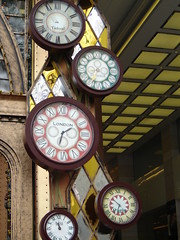
I've been investigating what it's like to keep up with my friends in what Mimi Ito describes as lightweight contact. Using mobile messaging and microblogging you end up with some rather portable friends who are doing their own thing in ways which interweave with your own everyday activities. As in more traditional forms of networking there seems to be an fluidity and an aggregation of communication, and something more substantial may emerge from that. I guess that's the sense in this post about the social web. Twitter's microblogging service, like Facebook prompts you to talk about the everyday in terms of what you are doing, giving you a semantic frame. But this is easy to subvert as friends tweet about the sites they're looking at, the projects they have in mind, and their more abstract musings. In a way, I suppose, these too are kinds of doing; kinds of doing, or ways of knowing, that form social ties in the particular kinds of networks we are anchored to.







